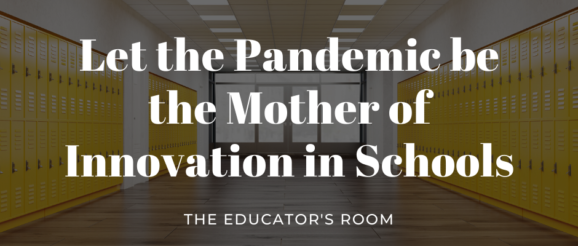Let the Pandemic be the Mother of Innovation in Schools | The Educators Room

The school year is winding down and the states are opening up. Some people are wondering how this summer is going to shape up. Will we be traveling? Having backyard barbecues? Going to the beach? Will we see a resurgence of COVID 19? Educators (and parents), however, are looking toward the fall. Will schools reopen? Will we be teaching remotely again? Will there be a mixture of the two?
I assert that we must not return to the same educational system we left behind in March 2020. We must take advantage of this tragic opportunity to recreate learning and public education. How can we possibly return to the past (albeit a past only months old) in the fall of 2020-2021? We cannot simply throw students who have had such disparate pandemic learning experiences back into the same academic churn. Once school reopens, we will have students with Individual Education Plans and English Learners who did not receive the services required for them to ‘keep up’ (a problematic concept I will address below); students for whom sitting in front of a computer is not the way they learn, students who lacked the technological access to participate in distance learning; students who, for a myriad of possible reasons, did not have the support, time or environment conducive to excel in the COVID Educational System.
It is folly to think we can resume teaching and learning in the system developed in this country in the early 1900s to impart upon immigrants to the United States the skills necessary to be a productive worker in the factories . . . be on time, follow directions, do not question authority, be satisfied in the monotony and tedium of performing the same physical task over and over. Now is the time to stop reforming ‘around the edges’ and make bold changes that will serve the needs of all students. I believe the following overhauls are a good place to start:
Finally, it is incumbent upon educational leaders to recognize that the entire world is experiencing historical and collective trauma. To think that we can return to the academic-focused culture of schools without making mental health a priority is sheer folly. Students and teachers alike will need social-emotional support as we transition to life after COVID 19 and establish a new ‘normal’ in society.
Educators need to spend the next several months looking beyond the physical and logistical precautions needed to make the building safe for teachers and students. Courageous leaders are needed to restructure teaching and learning, to ensure that our neediest students are not slighted or viewed as ‘lacking’ basic skills and to allow for paths to content and skill mastery that honor individuals’ strengths, challenges, and circumstances.
